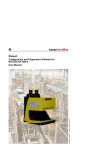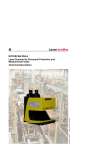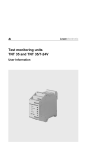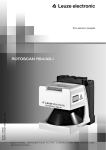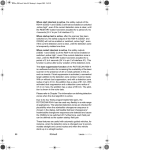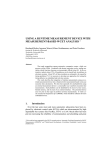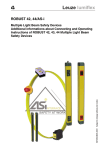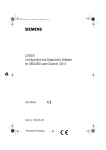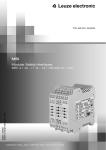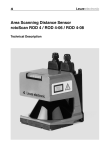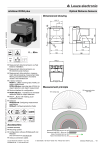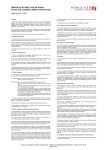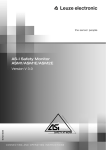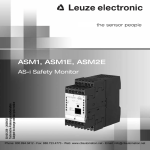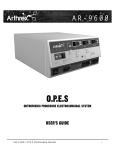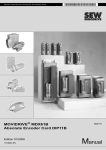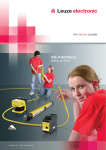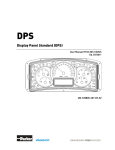Download RS4soft - Safety Camp
Transcript
RS4soft Configuration and Diagnostics Software for ROTOSCAN RS4-4 / RS4-4E 600706 - 03/05 A001 Subject to change without prior notice Operator´s Manual About the RS4soft operator's manual and the connecting and operating instructions of the RS4 These operating instructions for the RS4soft configuration and diagnostic software, and in particular the connecting and operating instructions for the ROTOSCAN RS4, contain important information on proper usage of laser scanners and usage in accordance with intended purpose. It is essential to observe all information in the connecting and operating instructions and in the operator’s manual, especially the safety notes. The connecting and operating instructions and the operator’s manual must be kept in a safe place. They must be available during the entire period when the ROTOSCAN RS4 is in use. Documentation is also automatically installed on the PC when RS4soft is installed and can be viewed at any time with the Help menu. Safety and warning notices are identified by the symbol . References to important information are identified by the symbol L References to the safety of laser devices are identified by the symbol . . Leuze lumiflex GmbH + Co. KG is not liable for damage caused by improper usage. The user must also be familiar with all the RS4 manuals to be able to use the system properly. Version: V1.12 © Reprinting and duplication is prohibited in whole or in part without prior approval of Leuze lumiflex GmbH + Co. KG Liebigstrasse 4 D-82256 Fürstenfeldbruck, Germany Tel. +49 81 41 / 53 50-0 Fax +49 81 41 / 53 50-190 E-mail: [email protected] http://www.leuze.de 2 RS4soft Contents 1 Getting Started . . . . . . . . . . . . . . . . . . . . . . . . . . . . . . . . . . . . . . . . . . . . . . . . . . . . . . . . . . . . . . 6 1.1 1.2 1.3 1.4 1.5 1.6 1.7 1.8 1.9 1.10 2 Calling Up RS4soft and Starting the System . . . . . . . . . . . . . . . . . . . . . . . . . . . . . . . . . . . . . 12 2.1 2.2 2.3 2.4 2.5 3 Menu Structure . . . . . . . . . . . . . . . . . . . . . . . . . . . . . . . . . . . . . . . . . . . . . . . . . . . . . . . . Main Menu Line . . . . . . . . . . . . . . . . . . . . . . . . . . . . . . . . . . . . . . . . . . . . . . . . . . . . . . . . Subject Line . . . . . . . . . . . . . . . . . . . . . . . . . . . . . . . . . . . . . . . . . . . . . . . . . . . . . . . . . . . Standard “Buttons” in the function line . . . . . . . . . . . . . . . . . . . . . . . . . . . . . . . . . . . . . . Information Field Line . . . . . . . . . . . . . . . . . . . . . . . . . . . . . . . . . . . . . . . . . . . . . . . . . . . Coordinate Control and Display . . . . . . . . . . . . . . . . . . . . . . . . . . . . . . . . . . . . . . . . . . . . Displaying Measurement Values and Zones in the Contour Area . . . . . . . . . . . . . . . . . . “Display Measurement Data” Subject Button 4.1 5 Establishing Communication from PC to RS4 . . . . . . . . . . . . . . . . . . . . . . . . . . . . . . . . . User Levels . . . . . . . . . . . . . . . . . . . . . . . . . . . . . . . . . . . . . . . . . . . . . . . . . . . . . . . . . . . Startup Page with Verification of Safety-Relevant Parameters . . . . . . . . . . . . . . . . . . . . Download Wizard for Access Level: Maintenance . . . . . . . . . . . . . . . . . . . . . . . . . . . . . Configuration Wizard for Access Level: Authorized User . . . . . . . . . . . . . . . . . . . . . . . . 12 13 13 14 14 Main Menu . . . . . . . . . . . . . . . . . . . . . . . . . . . . . . . . . . . . . . . . . . . . . . . . . . . . . . . . . . . . . . . . . 15 3.1 3.2 3.3 3.4 3.5 3.6 3.7 4 Foreword . . . . . . . . . . . . . . . . . . . . . . . . . . . . . . . . . . . . . . . . . . . . . . . . . . . . . . . . . . . . . . 6 Software Structure . . . . . . . . . . . . . . . . . . . . . . . . . . . . . . . . . . . . . . . . . . . . . . . . . . . . . . . 6 Required Components . . . . . . . . . . . . . . . . . . . . . . . . . . . . . . . . . . . . . . . . . . . . . . . . . . . . 6 System Requirements / Software . . . . . . . . . . . . . . . . . . . . . . . . . . . . . . . . . . . . . . . . . . . 7 System Requirements / Hardware (PC) . . . . . . . . . . . . . . . . . . . . . . . . . . . . . . . . . . . . . . 7 System requirements / hardware (cables, connectors) . . . . . . . . . . . . . . . . . . . . . . . . . . . 7 System Requirements - Other . . . . . . . . . . . . . . . . . . . . . . . . . . . . . . . . . . . . . . . . . . . . . . 7 Interface Pin Assignments . . . . . . . . . . . . . . . . . . . . . . . . . . . . . . . . . . . . . . . . . . . . . . . . . 8 Connecting the ROTOSCAN RS4-4 . . . . . . . . . . . . . . . . . . . . . . . . . . . . . . . . . . . . . . . . 11 Installing the Software . . . . . . . . . . . . . . . . . . . . . . . . . . . . . . . . . . . . . . . . . . . . . . . . . . . 12 15 15 15 16 16 17 18 . . . . . . . . . . . . . . . . . . . . . . . . . . . . . . . . . . . . 19 “Selection of Displayed Zone Pairs” Function Button . . . . . . . . . . . . . . . . . . . . . . . . . . . 20 “Configuration” subject button . . . . . . . . . . . . . . . . . . . . . . . . . . . . . . . . . . . . . . . . . . . . . . . . 21 5.1 5.2 5.3 5.4 5.5 5.6 5.7 5.7.1 5.7.2 5.7.3 5.7.4 5.8 “Load Configuration from File” Function Button . . . . . . . . . . . . . . . . . . . . . . . . . . . . . . . . “Save configuration to file, Function Button . . . . . . . . . . . . . . . . . . . . . . . . . . . . . . . . . . . “Load Configuration Data from File and Transfer to Scanner” Function Button . . . . . . . “Get Configuration Data from Scanner” Function Button . . . . . . . . . . . . . . . . . . . . . . . . . “Transfer Configuration Data from PC to Scanner” Function Button . . . . . . . . . . . . . . . . . . . . . . . . . . . . . . . . . . . . . . . . . . . . . . . . . . . . . . . . “Change Configuration Data with Wizard” Function Button . . . . . . . . . . . . . . . . . . . . . . . “Change Configuration Data” Function Button . . . . . . . . . . . . . . . . . . . . . . . . . . . . . . . . The “Configuration Parameters” Folder . . . . . . . . . . . . . . . . . . . . . . . . . . . . . . . . . . . . . . “Administative parameters” folder . . . . . . . . . . . . . . . . . . . . . . . . . . . . . . . . . . . . . . . . . . “Safety-relevant parameters” folder . . . . . . . . . . . . . . . . . . . . . . . . . . . . . . . . . . . . . . . . . “Zone Pair 1 to 4” folders . . . . . . . . . . . . . . . . . . . . . . . . . . . . . . . . . . . . . . . . . . . . . . . . . “Set Default Configuration Values” Function Button . . . . . . . . . . . . . . . . . . . . . . . . . . . . RS4soft 22 22 22 22 23 23 23 24 25 26 31 31 3 6 “Define Detect./Warning Zones” Subject Button . . . . . . . . . . . . . . . . . . . . . . . . . . . . . . . . . . 32 6.1 6.2 6.3 6.4 6.5 6.6 6.7 6.8 6.9 6.10 6.11 6.12 6.13 6.14 6.15 6.16 7 7.2 7.3 7.4 45 45 45 45 “View” menu . . . . . . . . . . . . . . . . . . . . . . . . . . . . . . . . . . . . . . . . . . . . . . . . . . . . . . . . . . “Settings” menu . . . . . . . . . . . . . . . . . . . . . . . . . . . . . . . . . . . . . . . . . . . . . . . . . . . . . . . . “Detection Zones/Warning Zones” . . . . . . . . . . . . . . . . . . . . . . . . . . . . . . . . . . . . . . . . . . “Security” menu . . . . . . . . . . . . . . . . . . . . . . . . . . . . . . . . . . . . . . . . . . . . . . . . . . . . . . . . “Help” menu . . . . . . . . . . . . . . . . . . . . . . . . . . . . . . . . . . . . . . . . . . . . . . . . . . . . . . . . . . . 46 46 48 49 49 Additional Information and Summary . . . . . . . . . . . . . . . . . . . . . . . . . . . . . . . . . . . . . . . . . . . 50 9.1 9.2 9.3 9.4 4 “Transfer Status Information from Scanner to PC” Function Button . . . . . . . . . . . . . . . . . . . . . . . . . . . . . . . . . . . . . . . . . . . . . . . . . . . . . . . . “Diagnostics List for Scanner Display” Function Button . . . . . . . . . . . . . . . . . . . . . . . . . “Initial Measurement for New Front Pane” Function Button . . . . . . . . . . . . . . . . . . . . . . “Reset scanner” Function Button . . . . . . . . . . . . . . . . . . . . . . . . . . . . . . . . . . . . . . . . . . . Additional Functions on the Main Menu Line . . . . . . . . . . . . . . . . . . . . . . . . . . . . . . . . . . . . . 46 8.1 8.2 8.3 8.4 8.5 9 34 34 34 34 34 35 35 35 36 38 39 40 41 41 42 42 “System data” subject button . . . . . . . . . . . . . . . . . . . . . . . . . . . . . . . . . . . . . . . . . . . . . . . . . 45 7.1 8 “Selection of Displayed Zone Pairs” Function Button . . . . . . . . . . . . . . . . . . . . . . . . . . . “Load Detection Zone/Warning Zone from File” Function Button . . . . . . . . . . . . . . . . . . “Save Detection Zone/Warning Zone as File” Function Button . . . . . . . . . . . . . . . . . . . . “Print Detection Zones/Warning Zones” Function Button . . . . . . . . . . . . . . . . . . . . . . . . “Select Detection Zone / Warning Zone” Drop-Down Button . . . . . . . . . . . . . . . . . . . . . . “Enter Detection Zone/Warning Zone Numerically” Drop-Down Button . . . . . . . . . . . . . “Define Elliptical Detection Zone/Warning Zone” Function Button . . . . . . . . . . . . . . . . . “Define Rectangular Detection Zone/Warning Zone” Function Button . . . . . . . . . . . . . . “Define Polygonal Detection Zone/Warning Zone” Function Button . . . . . . . . . . . . . . . . “Change Detection Zone/Warning Zone Segment” Function Button . . . . . . . . . . . . . . . . “Reduce Detection Zones/Warning Zone Limits” Function Button . . . . . . . . . . . . . . . . . “Blank Out Detection Zone/Warning Zone Segment” Function Button . . . . . . . . . . . . . . “Set detection zone segment as reference boundary“ Function Button . . . . . . . . . . . . . “Reset reference boundary definition of detection zone segment“ Function Button . . . . “Delete Detection Zone/Warning Zone” Function Button . . . . . . . . . . . . . . . . . . . . . . . . . “Transfer Detection Zone/Warning Zone from PC to Scanner” Function Button . . . . . . . Initial configuration . . . . . . . . . . . . . . . . . . . . . . . . . . . . . . . . . . . . . . . . . . . . . . . . . . . . . . Changing a Scanner Configuration or Zone Definition . . . . . . . . . . . . . . . . . . . . . . . . . . Creating a Configuration Without a Connected Scanner . . . . . . . . . . . . . . . . . . . . . . . . . Replacing Devices . . . . . . . . . . . . . . . . . . . . . . . . . . . . . . . . . . . . . . . . . . . . . . . . . . . . . . RS4soft 50 50 51 52 RS4soft 5 1 Getting Started 1.1 Foreword This manual describes the functional and performance features of the RS4soft software. RS4soft is an extremely powerful configuration and diagnostics software program designed for use with the laser scanners ROTOSCAN RS4-4 and RS4-4E. During development, the highest priorities were placed on reliability and userfriendliness. RS4soft is not suitable for configuring devices made by other manufacturers. The organization of this user manual parallels the sequences and hierarchies of the software menu points. The manual provides you with clear information regarding the structures and functions of RS4soft. Where more complex subjects are concerned, you can refer to the screen shot illustrations, which give you a concrete look at the points under discussion. The software itself offers an additional help text for each function button. Simply move the mouse pointer to a function button, and a descriptive pop-up window will appear automatically. 1.2 Software Structure RS4soft follows a subject-related tree structure: z The user interface was designed to be Microsoft®-compatible as far as possible in order to shorten the learning curve. z Subject buttons refer to function groups and the detailed functions incorporated in them. z Function buttons enable desired functions to be performed; many of these buttons offer dialog boxes and drop-down menus to simplify the selection process. z Standard buttons contain frequently required functions and are not linked to any specific subject. 1.3 Required Components The following components are required for the initial startup: 6 z Laser scanner RS4, installed as specified in connecting and operating instructions z PC or laptop with color monitor and installed RS4soft program z RS232 interface cable (1:1, without cross-connection) for connection X2 (see Chapter 1.8) z Control cable (power supply, changeover, restart) for the connection to X1 (see RS4soft Chapter 1.8) 1.4 System Requirements / Software Microsoft® Windows 95/98/NT®/2000/XP® 1.5 1.6 1.7 System Requirements / Hardware (PC) z Intel®-Processor class, Pentium® or higher (or compatible model, such as AMD® or Cyrix®) z At least 64 MB RAM z CD drive z Hard drive with at least 50 MB of free memory You may need more disk storage if detection zone data and/or configuration data are going to be stored. z Mouse z Free RS 232 serial interface, or alternatively, RS 422 interface System requirements / hardware (cables, connectors) z Wire cross-section of cable X1: at least 0.5 mm2 z Outer diameter of the cable: between 5 mm and 10 mm z Maximum cable length X1: 50 m z Maximum cable length X2: 10 m for RS 232 z Maximum cable length X2: 50 m for RS 422 z Use shielded cables z Use only the RS4-MG connectors and the RS4-MG cover provided with the delivered system. System Requirements - Other z Printer (black-and-white or color) Please refer to Chapter 3.2 in the connecting and operating instructions of the ROTOSCAN RS4-4 / RS4-4E. RS4soft 7 1.8 Interface Pin Assignments Interfaces of the ROTOSCAN RS4 Interface No. Interface type Interface function X1 SUB-D15 Connections for: • Power supply • Switch and signal cables X2 SUB-D9 Configuration and data interface for: ROTOSCAN RS4 - PC • Parameter configuration • Detection zone and warning zone definition • Data and measurement value transfer • Diagnostics Assignment of interface X1 FP 4 FP 3 FP 2 Alarm 1 FP 1 UB Restart GND 8 15 7 14 6 13 5 12 4 11 3 10 2 9 Alarm 2 NC NC OSSD2 OSSD1 NC NC 1 Pin assignments for interface X2 used as an RS 232 port Reserved TxD RxD Reserved GND/shield 1 2 3 4 6 7 8 9 RS232 detection NC NC Reserved 5 Pin assignments for interface X2 used as an RS 422 port Tx + Tx Rx Rx + GND/shield 1 2 3 4 5 6 7 8 9 RS432 detection NC NC Reserved Connection Pin 5 to pin 6 Fig. 1.8-1: Interface pin assignments with a view to the ROTOSCAN RS4-4 8 RS4soft PIN Signal Description 1 GND Power supply ground 2 Restart Input, scanner reset, and connecting the restart button of the restart button 3 UB +24-V DC power supply; protected by a 1.25 A delayed-action fuse 4 FP 1 Changeover to zone pair 1 5 Alarm 1 Semiconductor output that switches off when the warning zone is violated as well as for warning messages such as “window slightly dirty”, error messages such as “window very dirty”, and for internal errors (the functions can also be selected in combination) 6 FP 2 Changeover to zone pair 2 7 FP 3 Changeover to zone pair 3 8 FP 4 Changeover to zone pair 4 9 NC Do not assign 10 NC Do not assign 11 OSSD 1 Semiconductor output, switches off when the detection zone is violated, Channel 1 12 OSSD 2 Semiconductor output, switches off when the detection zone is violated, Channel 2 13 NC Do not assign 14 NC Do not assign 15 Alarm 2 Semiconductor output with shut-off when warning and malfunction message Table 1.8-1: Pin Assignments for Connector X1 A zone pair consists of one detection zone and one warning zone. RS4soft 9 PIN Signal Description 1 NC Reserved 2 TxD Data communication, transmit 3 RxD Data communication, receive 4 NC Reserved 5 GND/shield Ground / shield (connect with PE to the electronics cabinet only) 6 RS 232 Do not assign 7 NC Do not assign 8 NC Do not assign 9 Reserved Table 1.8-2: PIN Signal Description 1 Tx + RS 422 transmitted data 2 Tx - 3 Rx - 4 Rx + 5 GND/shield Ground / shield (connect with PE to the electronics cabinet only) 6 RS 422 Select RS 422 interface by connecting a bridge to pin 5 7 NC Do not assign 8 NC Do not assign 9 Reserved Reserved for testing purposes Table 1.8-3: 10 Reserved for testing purposes Pin assignments for connector X2 used as an RS 232 port RS 422 received data Pin assignments for connector X2 used as an RS 422 port RS4soft 1.9 Connecting the ROTOSCAN RS4 To configure the scanner, connect the control cable (X1) to the power supply (safety transformer 24 V, 2.5 A, 1.25 A semi-delay fuse) and the interface cable (X2) to the PC or laptop cable (X2) to the PC or laptop. Before starting up the system, please verify the connector assignments, the wiring, the supply voltage and the fuse protection. Although the scanner is robustly constructed and equipped with various internal safety mechanisms, it is possible that damage could be caused by faulty wiring. For further information, consult the connecting and operating instructions of the ROTOSCAN RS4 (Chapter 4.2). PIN Signal 1 GND 2 Restart 3 UB 4 FP 1 5 Alarm 1 6 FP 2 7 FP 3 8 FP 4 9 NC 10 NC 11 OSSD 1 12 OSSD 2 13 NC 14 NC 15 Alarm 2 a b c d = = = = a d b c STOP ok. ok. Connection for setting parameters only Dummy connector Connector X1 (15-pin, SUB-D) Connector X2 (9-pin, SUB-D) RS4soft 11 1.10 Installing the Software Please insert the CD-ROM in the appropriate drive. If the software settings of your PC allow it, the RS4soft installation routine starts automatically. It is also possible to start the routine manually by clicking on the “setup.exe” from the CD-ROM. After selecting the desired language you will be asked for the installation path. We recommend “C:\Program Files\Leuze lumiflex\RS4soft” as the path. After your entries are confirmed, the program is installed and the process is completed. Then RS4soft is ready for operation. To enable the program to be called up faster, use the Microsoft® function “Create shortcut” to add the RS4soft icon to the desktop. This makes it possible to load the RS4soft icon onto the desktop. For further detailed information, please refer especially to the connecting and operating instructions of the RS4 on the CD-ROM. 2 Calling Up RS4soft and Starting the System 2.1 Establishing Communication from PC to RS4 12 z Start the software by double-clicking either on “rs4_hmi.exe” or on the desktop icon. The starting page for the software appears for a few seconds, with the version number. After that the main menu appears with a dialog for selecting the authorization level (see Chapter 2.2). z Apply the supply voltage to the ROTOSCAN RS4-4. The scanner will now automatically attempt to communicate with your PC. z Once the PC and scanner have been successfully synchronized, the text in the info zone changes from “RS4 synchro” to “RS4 connect”. z The current configuration of the RS4-4 is transferred to the PC. A progress bar on the screen shows the configuration data being loaded. z Please replace the standard passwords with individual passwords. A request to this effect will appear on the screen (see Chapter 2.2 and 8.4). RS4soft 2.2 User Levels To ensure that the device configuration is performed only by trained and authorized personnel, RS4soft uses the dialog “Change authority level” to distinguish among various authorization levels providing access to various ranges of function. The following levels are available: Level Info field Password Access to functions User (Us) --- General settings, display and evaluation of measurement values, transferring configuration and status data from RS4-4 to PC, no changes to the system configuration Maintenance (Ma) RS4IGOY Device configurations can be loaded from a storage medium and saved in RS4-4. It is not possible to make changes to the parameters themselves. Authorized user (AU) RS4LEUZE Complete access to all user-related functions and parameters. Production (Pr) --- Manufacturer-specific access Development (De) --- Manufacturer-specific access Table 2.2-1: User levels The factory-preset password for the authorized user/safety official (AU) is “RS4LEUZE”. During the initial configuration of the ROTOSCAN RS4-4, the safety official must select and save new passwords for (Ma) and (AU); the (electronic or hardcopy) carrier of this information must be kept locked up in a secure location. Each password can be entered using either upper-case or lower-case letters; the password acceptance is not case-sensitive. The authorization level Since the authorization level “Userr” does not allow any changes to be made to the device configuration, it is not password-protected. After the authorization level has been determined, all inaccessible function buttons are disabled and colored light gray. 2.3 Startup Page with Verification of Safety-Relevant Parameters z The RS4 configuration and the status information are now automatically transferred and displayed. Please compare these safety-relevant data with the parameters required for the current application. z After you close the dialog box, the scanner configuration can be created or modified. RS4soft 13 2.4 Download Wizard for Access Level: Maintenance For the “Maintenance” access level, a wizard is offered automatically to set parameters for the scanner quickly and easily. For the options that are relevant here, please see Chapter 2.2. 2.5 Configuration Wizard for Access Level: Authorized User For the “authorized user” access level, a helpful wizard is offered so that you can set parameters for the scanner quickly and easily. All safety-related and non-safety-related dialogues will be shown here in a logical sequence. For every setting, you can view an explanation that is brief and to the point. This means that you can set parameters for the ROTOSCAN RS4-4 in all respects, without having to study the software at length. To find the information that is relevant here, please consult Chapter 2.3 and 5.7. 14 RS4soft 3 Main Menu 3.1 Menu Structure The main menu displays the measured contours and detection zones. It also features subject-related menu control and additional information fields. This is a very user-friendly method for changing the operating mode and for accessing many different dialogs and functions without losing track of what is going on. After selecting one of the four subject buttons, you can choose from relevant function buttons (icons) offering related selection boxes and drop-down menus. This method for guiding the operator is used throughout the program. 3.2 Main Menu Line This line contains the complete catalog of available functions. Please note that the functions are not available until the corresponding subject buttons have been activated. 3.3 Subject Line z “Display measurement data” button Measurement mode is activated; the current detection zone and warning zone are shown in red and green, respectively. Additional programmed zones can be selected individually by means of a dialogue (e.g. reference display). Zones that are not activated are shown in gray. z “Configuration” button All functions required for configuring the scanner are available here. z “Define detect./warn. zones” button This subject area allows you to create application-specific definitions of the four detection zones and the four warning zones using either the mouse or numerical input. z “System data” button This subject are contains data and dialogues for device identification event diagnostics and front pane calibration. RS4soft 15 3.4 Standard “Buttons” in the function line Frequently required functions are available at all times in the function line below the subject buttons, on the left in each case. 3.5 z Zooming (enlarge or reduce picture, total view of 80 x 140 m) z Change authorization level z End configuration program Information Field Line You can find information regarding the operating mode and the current authorization level in the information line at the very bottom of the screen as follows (from left to right): z z z z 16 Current data communication between PC and RS4 - “RS4 synchro” for synchronizing the communication between scanner and PC - “RS4 connected” when the data transfer connection is established Operating status of the scanner - “RS4 > Measures mode” for active recording of measurement data by the scanner - “RS4 > configuration” for the current transfer of configuration data with the OSSDs turned off - “RS4 > error” for indicating an event when the OSSDs are turned off Display of selected subject buttons - “Display measurement data” - “Configuration” - “Define detect./warn. zones” - “System data” Field status - Detection zone and warning zone violated/switched off – indicators DZ and WF are red - Warning zone violated – indicator WF is green - Detection zone and warning zone clear – no indicator RS4soft z z 3.6 Current access level Depending on the setting, the following abbreviations are displayed: - Us for user - Ma for maintenance - AU for authorized user - Pr for production (no access) - De for development (no access) Further messages and functions (below the contour field) include: - Name of the currently active zone pair, numbered from 1 to 4 - Zone Pairs displayed on the screen, numbered from 1 to 4, according to the selection in the selection dialog - Current source of data (RS4/file) - X/Y coordinates, angle and radius to indicate the pointer position in reference to the RS4 midpoint (see Chapter 3.6) - Positioning of the contour field and display optimization (see Chapter 3.6) Coordinate Control and Display In this part of the menu, located at the bottom right, the X and Y coordinates are displayed while the zones are being defined. In measurement mode, the position of the mouse pointer (“Position” line) is displayed. Or, if a zone (“Position” and “End position” lines) has been clicked on and dragged into position, it will be displayed. This feature makes it easy to localize objects and to create a detailed representation of particular areas. To the right, next to the coordinate display, are arrow buttons for selecting the image area of the detection zones and warning zones and the section of the measurement contour that you want to be displayed. A very convenient function is located behind the centering point. When you click here, the detection zone, warning zone and measured contour will be ascertained and automatically displayed optimized on the screen on their entirety. This feature gives you a quick overview of the zone proportions. RS4soft 17 3.7 Displaying Measurement Values and Zones in the Contour Area The following color assignments are used to make it easier to differentiate among the various contours: Contour Color Minimum detection zone Gray Detection zone Red Warning zone Green Measured contour Yellow / red Selected mouse pointer area Yellow Deactivated detection zone Light gray Deactivated warning zone Dark gray Mouse pointer Dark blue Table 3.7-1: Displaying Measurement Values and Zones in the Contour Area The information block in the main menu, bottom left, shows the display of the active zone pairs as well as the zone pairs selected for display. 18 RS4soft a b c d a h = = = = Standard buttons Subject buttons Functions buttons Detection zone and warning zone, inactive b c i d k h = Information field line i = Information block k = Detection zone, red, active Warning zone, green, active Measurement contour, yellow/red 4 e = Main menu line f = Function line g = Subject line f e l g m l = Coordinate display m = Contour zone positioning “Display Measurement Data” Subject Button This menu allows you to select the active and inactive detection zones and warning zones to be displayed as well as the measured contour of the room. Using constant comparisons, the ROTOSCAN RS4 ascertains the distance from the measured room contour to the detection zone and provides these data to the PC. If the measured contour penetrates the previously defined detection zone during a violation of the detection zone, the color of the measured contour in this area changes from yellow to red. RS4soft 19 4.1 “Selection of Displayed Zone Pairs” Function Button Click on the button “Selection of displayed zone pairs” to call up a dialog box for selecting the zone pairs to be displayed. Activated zone pairs appear in red/green and non-activated zone pairs in shades of gray. a = Function button as described above b = Dialog for selecting the zone pair display a b c d e f g h e = Information block about the activated zone pairs that are displayed f = Display of zone violation 20 c = Non-activated zone pair 2 d = Measured contour g = Violation of detection zone with change of color in measured contour h = Activated zone pair 1 RS4soft 5 “Configuration” subject button Select this menu for access to the configuration of the ROTOSCAN RS4. This subject area comprises data transfer as well as safety-relevant and non-safetyrelevant parameter settings of the scanner. Since this menu involves functions relevant to safety, please note that access is possible only when the appropriate password is entered. a = Catalogue of scanner configurations c = Entry of file name that have already been saved d = Confirmation of dialog entries b = Function buttons as described below a b c RS4soft d 21 5.1 “Load Configuration from File” Function Button Click on this button to open a dialog box providing an overview of the scanner configurations that are already saved in the PC. Enter and/or confirm the path and file name. Click on the button “Open” to confirm your selection, and the desired configuration will be called up. The standard configuration of the RS4, which is stored in the laser scanner upon delivery, is saved in the "RS4soft\examples" subdirectory under the name "standard.rs". This file, like all configuration files, contains all information to be processed in the scanner that is required for protective functions and operation. That includes all safety-related and non-safety-related parameters and all data sets for detection zones and warning zones and their contours and limits. The contents of the configuration data are explained in greater detail in Chapters 5.7 to 5.8. 5.2 “Save configuration to file, Function Button Click on this button to open a dialog box that allows you to save the currently defined scanner configuration together with all detection zones and warning zones. Enter and/ or confirm the path and file name. During the storage process, a progress bar with a confirmation message appears on the screen. The file extension is .rs. Configuration data is explained in greater detail in Chapters 5.7 to 5.8. 5.3 “Load Configuration Data from File and Transfer to Scanner” Function Button Click on this button to open a dialog box providing an overview of the scanner configurations that are already saved in the PC. Enter and/or confirm the path and file name. Click on the “Open” button to confirm your selection, and the desired configuration will be called up, and then a dialogue for further data transfer to the RS4 system will be displayed. Please take note here of Chapter 5.7, 5.5 and 5.2. 5.4 “Get Configuration Data from Scanner” Function Button Click on this button to load the configuration data from the RS4 onto the PC. These data can be subjected to further processing or revised, if desired, by personnel with the required authorization. During loading, a progress bar with a confirmation message appears on the screen. Configuration data is explained in greater detail in Chapters 5.7 to 5.8. 22 RS4soft 5.5 “Transfer Configuration Data from PC to Scanner” Function Button Click on this button to load the configuration data from the PC onto the RS4 and to save the configuration data. During the loading and saving process, a progress bar with a confirmation message appears on the screen. The information received by the RS4 will now be transferred back as echo data and displayed on the screen so that the safety official can confirm the transfer. Please note! Since the PC is not a safety product and computer-specific errors can occur, the echo data transmitted by the RS4 must be checked for errors and confirmed by an authorized person. Configuration data is explained in greater detail in Chapters 5.7 to 5.8. 5.6 “Change Configuration Data with Wizard” Function Button By clicking on the button, you can still call the configuration wizard at this stage so as to define the parameters for the scanner without loss of time. All safety-related and nonsafety-related dialogues will be shown here in a logical sequence. For every setting, you can view an explanation that is brief and to the point. This means that you can set parameters for the ROTOSCAN RS4 in all respects, without having to study the software at length. For more details, please see Chapter 2.3 and 5.7. 5.7 “Change Configuration Data” Function Button Click on this button call up a two-part dialog for changing safety-relevant and nonsafety-relevant parameters as well as data related to the zone pairs. This systemspecific data can be saved as a text file (“Create text file” button) with a .txt format. If you want to print it out immediately, you can do this be clicking on the “Print” button. The printers installed on Windows®, and also the number of copies to be printed, can be selected by the user as appropriate. The following information appears on the printout: z Date, user, data source z Scanner serial number, device type, firmware version z Administative parameters z Safety-relevant parameters z Information on the detection zones and warning zones of all four zone pairs After determining the scanner configuration, the setting must be documented in suitable form at the monitored machine or system. At this point you should print out the details of the configuration. RS4soft 23 c = Set value of parameters a = Data about detection zones and d = Parameter-related status display warning zones (folder) b = Parameters associated with selected folder a b c d e f g h e = Selection of printer f = Direct access to connection printer 5.7.1 g = Input field corresponding to selected parameters h = Saving of data in .txt format The “Configuration Parameters” Folder This folder contains the check sum of the complete configuration data file. Following a data transfer, for instance, this sum is compared with the newly calculated check sum. If a bit was falsified during the data transfer, the two sums will no longer agree and an error message will appear. 24 RS4soft 5.7.2 “Administative parameters” folder This folder contains the following functions: Parameters Function / setting Status Input options Scanner name Name of scanner, for example * As desired Additional description Description of application, etc. * As desired Output start segment Screen display of the first desired segment of the measured contour * 0 to 528 segments Screen display of the last desired segment of the measured contour * Output resolution Number of measurement values per display interval. The lowest value in each interval is displayed. * 1 to 8 consecutive measurements Serial interface Baudrate Change in the speed of data transmission * 4800 to 115,200 baud Depending on PC/laptop Alarm Signaling type Switches off the alarm output * Optionally for an device warning, a violation of the warning zone, or both Output stop segment Table 5.7-1: • 0 to 528 segments correspond to 190° • 14 to 514 segments correspond to 180° 0 to 528 segments • 0 to 528 segments correspond to 190° • 14 to 514 segments correspond to 180° Administative parameters RS4soft 25 5.7.3 “Safety-relevant parameters” folder This folder contains the following functions: Parameters Function / setting Status Input options Presettings Settings for restart interlock, response times, and scanner startup functioning * The detection zone restart time can be set from 160 ms to 10160 ms, or the restart can be performed manually. Detection zone and warning zone response time from 80 ms to 640 ms possible. Start interlock, startup test, automatic startup Measurement of start segment Measurementbased recording of the first contour segment R --- Measurement of stop segment Measurementbased recording of last contour segment R --- Dust suppression Optimizes freedom from interference * Activate or deactivate Admissible zone pair changeovers Determines sequence of changeovers as well as the startup zone pair * Two input fields are provided by a dialog. Click on the desired fields to make your selection. Table 5.7-2: Safety-relevant parameters In the status field R means “read only” and * means it is possible to change the parameters. The change in the parameters described above as no effect on the number of messages in ROTOSCAN RS4. 26 RS4soft Additional Information (administative parameters): z Start and stop segments: The output setting of the start and stop segments is used, for example, for contour measurement (e.g. 20 ° sections). This allows an individual, limited display of partial sections, for example for optimized display of critical areas during availability analysis. Modifying these values merely changes the display of the contours on the screen; the number of measurements taken remains the same. This reduces both the amount of data and the transfer time. z Output resolution: A mean value for the display can be selected regardless of the number of measurements taken. If “4” is entered, for example, the lowest value within each interval of 4 measurement points is plotted, and these successive values are used to create a line graph. Using this function results in a smoother display of the contours. For a detailed display, use setting “1”. Additional Information (safety-relevant parameters): z Presettings: Standardized parameter settings for safeguarding areas and safeguarding automatic guided vehicles (AGVs) are provided in a dialog. are provided in a dialog by way of example. Application Parameters Selection Factory setting Area guarding Startup type Restart DZ/WF response time Start interlock Manual 80 ms 80 ms x x x AGV Startup type Start interlock Startup test Automatic startup 2000 ms 80 ms 80 ms x Restart DZ/WF response time Table 5.7-3: x x Factory presettings RS4soft 27 a b c a = Selection of configuration block b = Display of selected parameters d c = Dialog for selecting presettings d = Display of startup functioning to be activated When start interlock is activated, the safety outputs of the RS4 (OSSD 1 and OSSD 2) will not be enabled or switched “active high” even if the current detection zone is clear, until the RESTART button has been actuated (24 V to pin 2 of interface X1). This function is automatically activated when manual restart is selected. When startup test is activated, after the scanner has been switched on, the safety outputs of the RS4-4 (OSSD1 and OSSD2) will not be enabled or switched “active high” even if the current detection zone is clear, until the detection zone is temporarily violated one time. When manual restart is activated, the safety outputs of the RS4 (OSSD 1 and OSSD 2) will not be turned on or switched to “active high” with the current detection zone released again until the Restart button has been actuated (24 V to pin 2 of interface X1). This function is active after every violation of the detection zone and depends on any detection zone changeovers. The Dust suppression function of the ROTOSCAN RS4-4 is a software function for increasing the availability of the laser scanner with small particles in the air such as chips or insects. If dust suppression is activated, a somewhat larger addition to the 28 RS4soft detection zone contour must be made. With or without dust suppression, and with a detection zone radius of up to 3.5 m, the addition has a value of 3.5 m 83 mm. With activated dust suppression and a detection zone radius of 3.5 m or more, the addition has a value of 100 mm. The addition is shown in the echo data. Please refer to Chapter 6 for information on defining detection zones when the dust algorithm is activated. Due to its four freely programmable zone pairs, the ROTOSCAN RS4-4 can be used very flexibly in a wide range of applications. The selected detection zones are checked for plausibility when the admissible changeover sequence is chosen in the dialog “Admissible zone pair changeovers”. Inadmissible changeover sequences are detected and cause the OSSDs to be switched off. Furthermore, each zone pair can be defined as the system startup zone pair. These features are useful with AutomaticGuidedVehicles, for instance, when the detection zone is changed over to accommodate straight and curved routes and when the vehicle starts up in a straight section. a = Path inside RS4soft c = Matrix for determining admissible b = “Change configuration data” function zone pair changeovers button d = Matrix for determining admissible startup zone pairs a b c RS4soft d 29 After the scanner configuration has been determined, it must be transferred to the scanner; to do so, click on the function button “Transfer configuration data from PC to RS4-4”. If you forget to do this, the transfer dialog is automatically called up before another subject button can be selected. Due to the safe protocol, you can now view and confirm the echo data reflected by the scanner. Please note! Since the PC is not a safety product and computer-specific computation errors can occur, the echo data transmitted by the RS4-4 must be checked for errors and confirmed by an authorized person. b a a = Display of RS4 echo data b = Configuration parameters c c = Selected settings If the echo data is not returned accurately, you must confirm the record by pressing the “Accept” button. Changing a configuration can require that the detection zones be checked again. For information on the echo data, please refer to Chapter 6.16. 30 RS4soft 5.7.4 “Zone Pair 1 to 4” folders Double-click on the folders to select the subfolders “detection zone” and “warning zone”. Selecting one of these subfolders causes zone-specific data to appear in the right-hand section of the dialog box: name of the zone, date and time of the latest change, zone status, and information on admissible zone pair changeovers. In addition, the minimum object width is stated with respect to the number of segments (x * 0.36°). This means that the lateral value in millimeters is dependent upon the maximum radius of the zone contour. 5.8 “Set Default Configuration Values” Function Button This function allows you to reinstate the factory-set configuration (delivery state) of the ROTOSCAN RS4-4. The table below describes the resultant setting: Parameters Value Parameters Value Detection zone range 4m Presettings Safeguarding an area Detection zone display 190 ° Restart Manual Detection zone Response time 80 ms Restart after reset Activated restart interlock Zone Pair changeover No changeover Startup operation Start interlock Startup zone pairs 1, 2, 3, 4 Dust algorithm Activated Detection zone name --- Start segment output 0 Warning zone range 5m Stop segment output 528 Warning zone display 190 ° Baudrate 57600 Bd Warning zone Response time 80 ms Name of scanner --- Alarm signaling type Warning zone violated Description of the scanner --- Table 5.8-1: Scanner default values RS4soft 31 6 “Define Detect./Warning Zones” Subject Button This menu provides you with extensive possibilities for defining detection zones. These include transferring data as well as creating and modifying the detection zones and warning zones. Since this area involves safety-relevant functions of the scanner, access is possible only when the appropriate password is entered. The smallest section of a detection zone must cover a lateral distance of at least 3.5 m. When defining detection zones, make sure that no pin-shaped contours are set, as these do not provide a guaranteed safety effect. b a c a b c d = = = = Not permissible Permissible Surrounding contour Detection zone line d The maximum selectable detection zone radii vary depending on the type of contour: 32 ROTOSCAN RS4-4 Range Factory setting Detection zone 4m 4m Warning zone 15 m 5m Contour measurement 50 m --- RS4soft The scanner is factory-programmed with semicircular detection zones (190°) which will be in effect after the initial startup. Please note that only detection zones (SF), and not warning zones (WF), may be used for the performance of safety-related tasks. a = Selection of displayed zone pairs d = Selection of detection zone/warning b = Load or saving detection zone/ zone basic contours warning zone data e = Tools for processing basic contours c = Print detection zones / warning zones f = Data transfer to scanner a g b e d c i h g = Zone catalog h = Base point of X and Y coordinates with left and right zone pair half RS4soft f k i = Detection zones and warning zones with factory settings k = Display optimization 33 6.1 “Selection of Displayed Zone Pairs” Function Button Click on the button “Selection of displayed zone pairs” to call up a dialog box for selecting the zone pairs to be displayed. No zone pair needs to be selected for a neutral contour display (e.g. for a printout). As soon as a zone is selected or a zone pair is selected by with control cable X1, the selected/activated zone pair appears on the screen again in RED/green. The selection is shown in Chapter 4.1. 6.2 “Load Detection Zone/Warning Zone from File” Function Button Click on this button to open a dialog box that will give you an overview of the zone configurations already saved on the PC after you have entered the appropriate path and the file name. You can call up the desired configuration (file extension “..sf”) using the “Open” button to make and confirm your selection. For information on transferring data to the scanner, see Chapter 6.16. 6.3 “Save Detection Zone/Warning Zone as File” Function Button Click on this button to open a dialog box that allows you to save the previously defined zone configuration. Enter the path and the file name. Click on the button “Save” to confirm your entry, and the configuration will be saved as a .sf file. In contrast to the “Save configuration” function, only data of a single detection zone or warning zone is saved with this function. This data can be transferred to other zone pairs, for example in the case of complicated zone contours or complementary zones in changeover mode. 6.4 “Print Detection Zones/Warning Zones” Function Button When you click on the button, a printing template will appear, with zone selection option, zoom function and assistance in positioning. This user-friendly function includes further possibilities for optimizing the graphic or the printout. To give a better overview, the window can be pulled up so that the graphic is fully displayed on the screen. 6.5 “Select Detection Zone / Warning Zone” Drop-Down Button When you click on this drop-down menu, all eight zones (4 detection zones and 4 warning zones) will be displayed for you to select. Use the mouse to click on the zone pair you want to define. The current contours of the detection zone and warning zone will be shown in red and green, respectively. Unselected zone pairs appear in gray/light gray. 34 RS4soft 6.6 “Enter Detection Zone/Warning Zone Numerically” Drop-Down Button Click on this button to open a dialog box for numerically entering the dimensions of the detection zone/warning zone in millimeters. You can enter dimensions for the front, left and right edges of the zone to be defined. Confirm the edge dimensions. These will then be displayed on the screen in the appropriate color (detection zone in red, warning zone in green). Please refer to the sub-item “190° zone pairs” in Chapter 8.2. 6.7 “Define Elliptical Detection Zone/Warning Zone” Function Button When you click on this button, all of the tools except zooming appear against a light gray background. The program now waits for you to position the mouse pointer and set the coordinates for the elliptical contour. As long as the mouse button remains pressed within the contour zone, you can freely shift the current ellipse contour in the X and Y directions. The coordinate display is useful in helping you check your setting of the blanked out area. When you have finished demarcating the zone, release the right mouse button. The set mouse pointer marks the intersection of the horizontal and vertical line going to each side of the ellipsis. Equivalent sections of the zone are always generated in the left and right halves of the display; these sections can be modified separately at a later point in time. Please refer to the sub-item “190° zone pairs” in Chapter 8.2). 6.8 “Define Rectangular Detection Zone/Warning Zone” Function Button When you click on this button, all of the tools except zooming appear against a light gray background. The program now waits for you to position the mouse pointer and set the coordinates for the rectangular contour. You can freely change the rectangular contour in the X and Y directions as long as you keep the right mouse button pressed within the contour zone. The coordinate display is useful in helping you check your setting of the blanked out area. When you have finished demarcating the zone, release the right mouse button. The set mouse pointer marks the corner point of the horizontal and vertical line of the rectangle contour. Equivalent sections of the zone are always generated in the left and right halves of the display; these sections can be modified separately at a later point in time. Please refer to the sub-item “190° zone pairs” in Chapter 8.2). RS4soft 35 a = Detection zones and warning zones c = 1 to 4 (each) b = X, Y line peak values, defined with the “Define Elliptical Detection Zone/ d = Warning Zone” a b Maximum rectangular values determined with the “Define Rectangular Detection Zone/Warning Zone” button Selection of four zone base contours c e f e = Distinction between left and right zone pair half by leading sign f = Zone Pair center line d g g = Mouse pointer coordinates A minus sign preceding the mouse pointer coordinates designates the left half of the zone pair, or the area below the scanner zero axis. 6.9 “Define Polygonal Detection Zone/Warning Zone” Function Button When you click on this button, all of the tools except Zooming appear against a light gray background. 36 RS4soft The program now waits for you to position the mouse pointer. Click on the left-hand mouse button to “draw” the contour of the polygon point for point. If the scanner is down in the contour display, the input of contour points will always be clockwise from left to right. If the scanner is up (contour display rotated 180°), the input will be in the opposite direction. As long as the mouse button remains pressed within the contour zone, you can freely shift the current line segment in the X and Y directions. The coordinate display is useful in helping you check your setting of the blanked out area. Once you release the mouse button, the process is complete and the line is set. If a correction is needed, the “Delete course of polygon contour step by step” function appears in the function button line. Every time you click, a contour segment is deleted. Another line is added with each click using the mouse pointer until the figure is complete. To do this, simply click the right mouse button. Please note the sub-item “190° Detection Zones” and “Rotate Contour Display 180 °” (Chapter 8.2). a b d c e f d = End point – complete by clicking with a = Button for activating the polygon function the right mouse button b = e.g. 1st, 2nd, 3rd and 4th mouse click e = Measured contour f = Delete individual segments for the current zone c = Displayed deactivated detection zone and warning zone (gray tones) RS4soft 37 6.10 “Change Detection Zone/Warning Zone Segment” Function Button Once a contour is specified, it can be modified by setting coordinate points with respect to the beam axis. When you click on this button, all of the tools except zooming and the deletion function for polygon segments appear against a light gray background. The program now waits for you to position the mouse pointer and click, thereby setting the coordinates to be corrected. Use the coordinate display to check your selection. The section of the contour between the points is a line showing the connections to the previous contour. The connection itself follows the beam axis. After you have set the first corrective point, the program provides you with a yellow auxiliary line as a reference. a = Connecting lines based on the beam c = Step-by-step deletion of the course of axis a polygon b = Button for activating segment change (sample function active) a b d e d = Sample contour for comparison e = Auxiliary line (beam axis) 38 c f f = Coordinate points RS4soft 6.11 “Reduce Detection Zones/Warning Zone Limits” Function Button Click on this button to open a dialog box that allows you to limit the dimensions of the zone by making a numerical input in millimeters. This refers to the front, left and right edges of the zone. After you confirm the edge dimensions, the limited contour will be displayed. a c b d a = Limit value to be entered in the dialog c = Reduced contour b = Button for activating segment d = Sample contour for comparison reduction RS4soft 39 6.12 “Blank Out Detection Zone/Warning Zone Segment” Function Button Once a contour is specified, you can blank out segments of the detection zone by setting two coordinate points. The segments between these two points will be blanked out. When you click on this button, all of the tools except zooming appear against a light gray background. The program now waits for you to position the mouse pointer and click, thereby setting the coordinates for the beginning and the end of the segment to be blanked out. The section of the contour between the points is blanked out in the direction of the beam axis. After you have set the first corrective point, the program provides you with a yellow auxiliary line as a reference. The coordinate display is useful in helping you check your setting of the blanked out area. a = Button for activating the segment change a b c b = Sample contour for comparison c = First and second Coordinate point d d = Connecting lines based on the beam axis If you blank out sectors that can be entered or walked through, hazards to personnel can result if the minimum safety distance is no longer met. Additional measures must be taken to safeguard the danger zone in such cases. 40 RS4soft 6.13 “Set detection zone segment as reference boundary“ Function Button If a contour is prescribed, the setting of two coordinate points makes it possible to define sectors of the detection zone between these points as a reference boundary. When you click on this button, all other tools apart from the zooming function will be shaded in light grey. The program now expects you to position the mouse arrow by clicking, and so to define the coordinates for the starting point and the end point of the sectors to be defined as a reference boundary. To help you get your bearings, after the first correction point has been set the program offers you a yellow alignment guide. The display of coordinates here serves as a control. The contour section lying between the starting point and the final point will be shaded grey in the direction of the beam access until you release the mouse button. Sectors with a reference contour will be shown blue in the display when you have finished defining the zone. Only detection zone sectors (not warning zone sectors) can be defined with a reference boundary. In detection zone sectors with a reference boundary the ROTOSCAN RS44E will not just guard against any breach of the detection zone; it will also monitor the exact status of the values registered in these sectors. If these registered values deviate from the defined reference contour by more than the tolerance zone permits, the laser scanner will switch off and the OSSDs will also be set to Off. When moving from detection zone sectors with a reference boundary to detection zone sectors without a reference boundary, you must ensure that the transition is smooth (see illustration). Here the reference contour is to be positioned on the measurement contour, and the boundary of the detection zone a little before the measurement contour. When the presettings “Whole body trip control”, “Arm detection” and “Hand detection” have been selected, the entire boundary of the detection zone will automatically be defined as a reference boundary. Parts of it may be reset again. A definition of the detection zone that does not include a large number of sectors with a reference boundary will be rejected by the ROTOSCAN RS4-4E, and it will not be possible to load the detection zone to the laser scanner. 6.14 “Reset reference boundary definition of detection zone segment“ Function Button If you wish to reset the reference boundary definition for sectors of the detection zone, you should proceed in an analogous manner to that used when defining a reference boundary for a detection zone sector. Detection zone sectors with a reference contour are indicated in blue, detection zone sectors without a reference contour, like boundaries of the detection zone, are indicated in red. Position the mouse pointer in the area where you want to reverse the reference boundary definition. By clicking you initiate the resetting. Move with the mouse pointer over all the sectors that you want to reset. The portion of the contour between the starting point and the final point will be shaded grey in the direction of the beam axis until you release the mouse button. After you release the mouse button the highlighted sectors are again recognisable, in view of the red colour, as boundaries of the detection zone. When the presettings “Whole body trip control”, “Arm detection” and “Hand detection” have been selected, the entire boundary of the detection zone will automatically be RS4soft 41 defined as a reference boundary. Parts of it may be reset again. A definition of the detection zone that does not include sectors with a reference contour will be rejected by the ROTOSCAN RS4-4E, and it will not be possible to load the detection zone to the laser scanner. a b c c a = Button “Set detection zone segment as c = Transitional phase between detection reference boundary” zone segments with and without b = Button “Reset reference boundary reference boundary definition of detection zone segment”” 6.15 “Delete Detection Zone/Warning Zone” Function Button If you select this function, the detection zone definitions and warning zone definitions are replaced by the factory settings (4 m radius for the detection zone, 5 m radius for the warning zone). 6.16 “Transfer Detection Zone/Warning Zone from PC to Scanner” Function Button Click on this button to open a dialog box that gives an overview of the previously changed zone contours. This list allows you to select the zones that you want to be transferred to the RS4. 42 RS4soft Once the dialog has been confirmed, the loading/saving process begins and a progress bar appears on the screen. The ROTOSCAN RS4-4 sends the information it received back to the PC as echo data so that the data transfer can be verified. The transferred detection zone contours appear in a dialog; the contours must be checked and the dialog must be acknowledged accordingly. After the check sums have been recalculated, the transfer is concluded with an OK message. Please note! Since the PC is not a safety product and computer-specific occur, the echo data transmitted by the RS4 must be checked in detail for errors and confirmed by an authorized person. a = Number of the Detection Zone b = Automatically determined Detection Zone Addition b a c d e c = Echo dialog d = Echo data contour e = Recorded detection zone maximum values RS4soft f g f = Date of save, permissible FP changeover g = Detection zone to the transferred 43 The echo data contain the detection zone contours, the maximum dimensions, the detection zone number, the date and time they were saved, the admissible detection zone changeovers, and the display of the detection zone addition. The latter point must first be considered by the user when defining the detection zones. For further directions, consult the connecting and operating instructions of the ROTOSCAN RS44 / RS4-4E. After the detection zone definition has been completed, it must be documented in a suitable form at the monitored machine or system. Read Chapter 8.1 to find out how to save a detection zone contour. Read Chapter 6.4 to find out how to print a detection zone contour. After the configuration has been completed, it must be documented in a suitable form at the monitored machine or system. For the saving of the configuration data please see Chapter 5.2. For information on printing the configuration data, please see Chapter 5.7. 44 RS4soft 7 “System data” subject button This menu allows you to call up device-specific identification data and special functions. 7.1 “Transfer Status Information from Scanner to PC” Function Button Clicking on this function button transfers the RS4 configuration to the PC and displays: z Scanner name, description z Serial number, firmware z Safety-relevant settings of the scanner z Permitted zone pair changeovers z Date the zone in question was last saved z Output resolution This data can also be saved on the PC and/or printed out as a text file. 7.2 “Diagnostics List for Scanner Display” Function Button This function button provides you with access to an RS4-internal ring memory in which the diagnostic messages of the eight most recent events are documented. The first position of the memory contains the most recent message. In addition, you can see the sum of all the generated messages. The information in the list makes it possible to draw very good conclusions about a wide range of external events such as circuit, wiring and time errors, etc. For detailed information and an additional list of diagnostic codes, please refer to the connecting and operating instructions of the RS4. 7.3 “Initial Measurement for New Front Pane” Function Button It is necessary to perform a device-internal calibration of front pane monitoring after the front pane of the scanner has been replaced, for instance. Please note that only trained, expert personnel are allowed to replace and calibrate the front pane. This function can be accessed beginning at the “Authorized user (AU)” access level. For information on the password, see Chapter 2.2. 7.4 “Reset scanner” Function Button Click on this function button to send a reboot command from the PC to the scanner. This function can be used, for instance, if there is no manual RESTART button and an error message was issued due to dirt buildup on the scanner window. Once the front pane has been cleaned and the message has been reset, the scanner resumes its normal operation. RS4soft 45 8 Additional Functions on the Main Menu Line This section describes additional special functions that are not provided by the subject buttons. 8.1 “View” menu “Save Diagram as File” Function Click on the sub-item “Save diagram as a file” to open a dialog box for saving the displayed detection zone and warning zone contours in .bmp format (bitmap). For documentation purposes, this screen shot can be called up using the program MS-Paint®, for instance, and supplemented with additional information. Enter the path and file name, and then confirm both in order to save the diagram as a file. During the storage process, a progress bar with a confirmation message appears on the screen. 8.2 “Settings” menu “PC configuration” sub-item “Interface” function Click on the sub-item “Interface” to open a dialog box that allows you to set the parameters for the interface (com-port) and the baud rate (data transfer speed). Please note that very high transfer rates also require correspondingly powerful PC hardware. “Language function Click on the “Language” sub-item to open a dialog box that allows you to select the language of the user interface and the program texts. Please note that a change in language will not take effect until the RS4soft program has been restarted. “Change diagram color” function Click on the “Change diagram color” sub-item to change the background color of the contour window from black to white (and vice versa). This function makes the screen shots of the measurements more suitable for printing. “Rotate contour display 180°” function This very convenient function makes it possible to display a contour rotated by 180°. If the scanner is placed on a machine and its vision direction faces the user, then any zone check will have a better overview. 46 RS4soft “190° detection zones and warning zones” function Click on the “190° detection zone/warning zone” sub-item to expand the definition of detection zones and warning zones by 10°. The displayed range is extended -5° to the left and +5° to the right. This does not affect the recording of measurement values, generally 190°. “Activity list” sub-item Click on the “Display messages” sub-item to open an information window showing a list of the operator steps performed since the software startup. To give a better overview, the window can be pulled up so that the graphic is fully displayed on the screen. RS4soft 47 8.3 “Detection Zones/Warning Zones” “Modified detection zones/warning zones” function Click on the “Modified detection zones/warning zones” sub-item to open an information window showing all of the detection zones and warning zones that have been modified in the PC but have not yet been saved to the RS4-4. Each of these zones is identified by a marker. The markers remain in place until the detection zones and warning zones are saved to the RS4. “Print” function When you click on the “Print” subheading, a printing template will appear, with zone selection option, zoom function and assistance in positioning. This user-friendly function includes further possibilities for optimizing the graphic or the printout. To give a better overview, the window can be pulled up so that the graphic is fully displayed on the screen. a b a = Selection of zone to be printed b = Optimization of zone display 48 c c = Positioning of printing template RS4soft 8.4 “Security” menu “Change password” function When you click on the “Change password” sub-item a dialog appears where you can specify passwords for the “Maintenance [Ma]” and “Authorized user [AU]” access levels. Passwords must be entered again in a different input box for confirmation. To select the access level, choose “Change authorization level”. Note that the “Authorized user (AU) access level is required to change passwords. Please note that an access level of “Authorized user (AU)” is required in order to be able to change the passwords. The characters being entered are concealed from view. Please keep the password in a location that is inaccessible to unauthorized personnel. “Reset password” function In the event that a password is lost, it is possible to define a new password. Use the “Reset password” and “Generate one-shot password” sub-items to create a security password that is shown in red. Fax or mail this password to Leuze lumiflex along with the complete address of your company, the user name, and the scanner serial number. You will immediately be sent a confirmed one-shot password which must be entered in the “Setting new passwords” dialog. Once the new passwords have been entered in both fields, you can access the scanner on the “Authorized user (AU)” level. If the confirmed one-shot password is entered incorrectly, the ROTOSCAN RS4-4 signals an event message at LED 5. In addition, a message to that effect will appear on the screen after approx. 2 minutes. Please note that RS4soft is disabled during this time period and will not be able to process any new entries. 8.5 “Help” menu Selecting this option allows you to view the connecting and operating instructions of the RS4, the operating instructions of RS4soft and the diagnostic code list (assuming a pdf reader program is available). “Info” function The “Info” sub-item shows the software version and the time at which the RS4soft software was created. RS4soft 49 9 Additional Information and Summary 9.1 Initial configuration 9.2 50 z Carefully study the guidelines and standards that are valid for your application. (Consult Chapter 1.4 of the RS4 connecting and operating instructions.) z Read the RS4soft User Manual and the connecting and operating instructions of the ROTOSCAN RS4-4 / RS4-4E thoroughly. z Start your PC with all required peripheral devices – but without the scanner connection. z Install and start RS4soft. z When unpacking the RS4, avoid touching the front pane and the diffusing screens. z Plug in the RS4 using connector X1 as described in the instructions. z Connect the RS4 to the PC using connector X2 as described in the instructions. z Once the operating voltage is applied, the scanner signals communication readiness after approx. 20 s. You can see this state when the message “RS4 connect” appears on the screen. z The RS4 is delivered with factory-set standard parameters programmed for the maximum detection zone size. z As a result of the factory setting, each zone pair consists of a detection zone and a warning zone with exactly the same dimensions, making them appear as a single contour. It is always a zone pair that is activated. z Since restart interlock is activated, it is not possible to enable the OSSDs until 24 V is applied at pin 2 of connector X1. Please note the supply voltage specifications in the connecting and operating instructions of the ROTOSCAN RS4-4 / RS4-4E, Chapter 3.2. z Please be aware of detection zone violations which may occur due to the maximum selected size of the detection zone. z Please document the scanner configuration as specified in Chapter 5.7 and 5.8. Changing a Scanner Configuration or Zone Definition z Faultless data communication must be established before any changes can be made. This state is signaled on the screen by the message “RS4 connect”. z In order to make changes, you must have access to the authorization level “Authorized user”. z Changes are only possible if a configuration has been loaded onto the PC. You can load a configuration either from the hard drive or from the RS4. z Changes to a configuration are not accepted by RS4soft until you confirm them by pressing the buttons “Accept” or “OK”. RS4soft 9.3 z Changes do not take effect until the data has been successfully transferred to the scanner. z If detection zones are loaded as a file from the hard drive, for instance, you must verify the plausibility of the scanner configuration. z Please consider the necessary safety distance and the required additions to the detection zone. z Do not fail to comply with the safety notes in the connecting and operating instructions of the RS4. z Please document the scanner configuration as specified in Chapter 5.7 and 5.8. Creating a Configuration Without a Connected Scanner z After calling up RS4soft, select the authorization level “Authorized user”. z The initial display of the measurement zone does not show any zone contours. z Enter the password for the appropriate user level. z You can use the “RS4 configuration” subject button to load a configuration file from the hard drive onto the PC. The file extension is “.rs”. z Note that configuration files contain scanner configurations as well as zone definitions. z You can use the subject button “Define detection zones/warning zones” to load a zone file from the hard drive onto the PC. The file extension is “.sf”. z Please note that zone files do not contain any scanner configurations. z Saved files can be loaded onto the ROTOSCAN RS4. RS4soft 51 9.4 52 Replacing Devices z After a replacement scanner has been connected to the PC, load the configuration data first. The status information will then be displayed on the screen so that it can be verified. z One way to identify configurations is by generating the date and time when the zone was saved. z If the scanner is new, you can program it more quickly by transferring the previous configuration file, as long as this still corresponds to the requirements of the application. z When replacing a device, make sure that the scanner parameters and the complete detection zone definitions are transferred correctly. z Compare the data of the previous scanner with the echo data of the new scanner. z Note the safety notes in the connecting and operating instructions of the ROTOSCAN RS4-4 / RS4-4E. z Please document the scanner configuration as specified in Chapter 5.7 and 5.8. RS4soft




















































